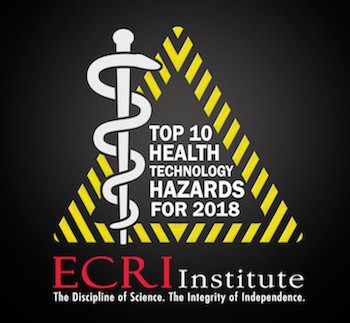- Politics
- Diversity, equity and inclusion
- Financial Decision Making
- Telehealth
- Patient Experience
- Leadership
- Point of Care Tools
- Product Solutions
- Management
- Technology
- Healthcare Transformation
- Data + Technology
- Safer Hospitals
- Business
- Providers in Practice
- Mergers and Acquisitions
- AI & Data Analytics
- Cybersecurity
- Interoperability & EHRs
- Medical Devices
- Pop Health Tech
- Precision Medicine
- Virtual Care
- Health equity
Cybersecurity Threats, Digital Failures Top Hospital Hazards List
"Patient safety is on everyone's mind, but technology safety sometimes gets left behind."

The ECRI Institute today released its list of top healthcare technology hazards for 2018, outlining major areas of concern for hospital administrators in the coming year. Many items involve patient infection from unclean equipment, but digital threats staked their place as equal or even greater dangers to patient safety.
Topping this year’s rundown are ransomware and other cybersecurity threats. Patients can be harmed by workflow disruptions, data exposure, and damaged equipment that lead to appointment cancellations, confusion, and facility closure, ECRI points out. Disruptions to essential third-party services used by hospitals can be just as damaging as the facility becoming infected.
The authors echo calls for proactive participation from senior leadership in efforts to thwart malware attacks.
Other digital hazards made the list. Inappropriately configured secondary alarm systems came in at No. 4. Patients can suffer when medical devices or information technology systems fail to deliver timely information to clinicians’ communications devices. Recently reported incidents include alarms being delivered to all clinicians rather than the intended targets, messages failing to deliver following an antivirus update, and conflicts between alarm systems and other applications on a user’s smartphone.
The ECRI team considers the problem mostly avoidable but only if care is taken during configuration, implementation, and verification of the systems. They recommend periodic assessments of the system’s integrity during use.
Digital communications return to the list at No. 9. “Inattention to best practices for implementing networked medical systems can lead to incorrect or incomplete data transfers,” the report states. “Such errors can delay diagnosis or treatment or prompt a misdiagnosis.” Incomplete transfers of lab information into electronic health records or from medical equipment into patient monitors can cause catastrophic, unnecessary changes in care.
As the networked devices begin to dominate healthcare, the report urges facilities to assess, approve, and implement changes “in a controlled manner.”
"Patient safety is on everyone's mind, but technology safety sometimes gets left behind," David T. Jamison, executive director of the Health Devices Group at ECRI Institute, says in a statement. "We know what can go wrong and what steps hospitals can take to reduce patient harm related to specific technologies and processes."
Jamison’s group compiles the list annually to inform healthcare facilities on risk mitigation. They survey technology ranging from “beds and stretchers to large, complex imaging systems,” to provide a full look at what equipment protocol may need to be addressed to ensure patient safety. Preventability factors heavily into the development of the list, alongside the breadth, frequency, severity, and insidiousness of each issue.
The full list from this year’s Top 10 Health Technology Hazards for 2018 executive brief is as follows:
1. Ransomware and other cybersecurity threats
2. Endoscope reprocessing failures
3. Infection risk from microbiological contaminants on mattresses and covers
4. Missed alarms from improperly configured systems
5. Improper cleaning of devices
6. Unholstered electrosurgical equipment
7. Inadequate use of digital imaging tools
8. Workarounds to bar-coded medication administration systems
9. Flaws in medical device networking
10. Slow adoption of safer enteral feeding connectors
